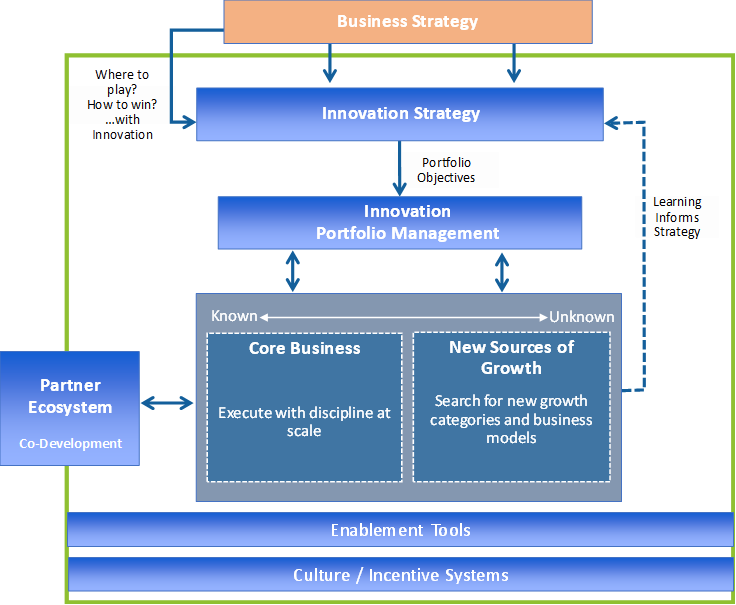Transforming an organization’s innovation capability is hard work. We all know that. Companies typically start their improvement journey by making changes where there is an immediate need–implementing an improved, gated-development process to guide core business execution or adopting design thinking and lean startup methods to more effectively create new sources of growth are examples.

The results these practices provide can be significant, but unfortunately, they represent only a fraction of the potential value they can provide, and success is hard to sustain unless they are implemented as part of an interdependent innovation system.
The above graphic shows innovation as an integrated set of capability areas in which key elements, each with their own processes, organizational structures, governance mechanisms, workflows, and tools, work together as a system.
While each element can be improved separately with great success, maximum benefit comes when all elements work together.
The ultimate success of any one element depends on the effectiveness of the others. New category creation, for example, works best when you have the portfolio management discipline to investment in it, while simultaneously investing in today’s core business without shutting down promising early stage opportunities every time quarterly financial pressure rises.
Likewise, if leadership does not align on a clear innovation strategy to guide investment allocation, considering organic growth goals, return objectives, risk tolerance, M&A, and co-development activity, execution of that strategy can quickly become rudderless and ineffective.
Over the last few years, design thinking, lean startup, and agile methods have emerged as the predominant approaches for new growth innovation.
Thanks to entrepreneurial-minded thought leaders like Steve Blank, Eric Ries, Alex Osterwalder, Rita McGrath, Brant Cooper, and others, companies now have a methodology and growing toolset appropriate for discovering, incubating, and scaling new, disruptive sources of growth.
Companies like Intuit, GE, W.L. Gore, ING, Toyota, and City Ventures have adopted lean innovation techniques (practices that draw from design thinking, lean startup, and agile methods) and are seeing meaningful results.
However, they are also realizing that they cannot simply train the masses and roll out lean innovation tools alone. Training in lean methodology is not enough. Early adopters of lean innovation realize that embedding the approach in a large enterprise optimized for scale efficiencies requires careful integration within a broader innovation system.
Here are a couple system interdependency examples taken from my recent client work:
- Core Business Execution < > Portfolio Management
A medical device company, three years into an innovation improvement initiative, was frustrated that they were only seeing marginal improvements in time to market and schedule predictability. Their execution engine performance had plateaued.
It wasn’t until they performed a portfolio rationalization, killing resource-intensive, low-value projects and diverting resources to chronic bottleneck functions, that they saw significant improvement in development throughput.
Today, a more disciplined portfolio and resource management process helps them identify downstream constraints in time to flex capacity and proactively reallocate resources to avoid costly project delays.
- Innovation Strategy < > Portfolio Management < > External Partner Co-Development
An industrial equipment manufacturer, despite churning out a steady stream of product line extensions, found that their once double-digit growth had stalled. An analysis of projects in their development pipeline showed a disproportionate investment in incremental and sustaining projects.
Company leaders realized they needed to revisit their innovation strategy—they decided to emphasize a more balanced portfolio that included investment in new growth categories. They decided to kick off an initiative to tap into a vibrant start-up ecosystem where they could leverage development partnerships to co-create new sources of growth.
Many companies have improved one or more of the innovation system elements, only to be disappointed when overall results fall short of expectations. Piecemeal improvements lead to frustration when projected benefits are not achieved.
It takes a coordinated set of integrated initiatives that support and reinforce one another to achieve truly transformational results.
In an upcoming article, I will detail the linkage between strategy and execution and provide practical tips to help you avoid the interdependency problems that most often trip up organizations.
You can read more by Noel Sobelman on Innovation, here
Article by channel:
Everything you need to know about Digital Transformation
The best articles, news and events direct to your inbox
Read more articles tagged: Featured, Innovation









